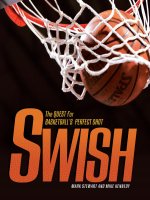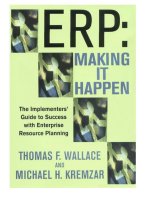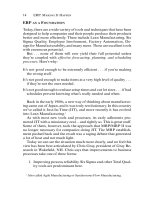Swish: The Quest for Basketball''''s Perfect Shot ppt
Bạn đang xem bản rút gọn của tài liệu. Xem và tải ngay bản đầy đủ của tài liệu tại đây (9.4 MB, 68 trang )
THIS PAGE
INTENTIONALLY
LEFT BLANK
J
The following images were provided by the Authors: Naismith Memorial Basketball Hall of Fame, pp. 6, 11; YWCA USA, p. 8 (bottom); Murad Tobacco,
p. 10; Capital Cards, p. 12; Spalding Sporting Goods, p. 13; Sheboygan County Historical Research Center, pp. 18, 19 (bottom); Bowman Gum Co., p. 19
(top); Editions Recontre S.A., p. 21 (top); Topps, Inc., pp. 21 (bottom), 29 (bottom), 33 (bottom); Collegiate Collection, pp. 23 (top), ; Courtside Collection,
pp. 23 (bottom), 25 (bottom); From the Authors’ Collection, pp. 25 (top), 31 (bottom); Duke University, p. 26; Classic Games, Inc., p. 27 (both); Fleer
Corp., pp. 29 (top), 50; WNBA Enterprises, LLC, p. 31 (top); General Mills, Inc., p. 33 (top); The Nera Collection, p. 40.
The following images are used with the permission of: © iStockphoto.com/Joachim Angeltun, pp. 1, all backgrounds; © Ronald Martinez/Getty Images,
p. 4; © Hulton Archive/Getty Images, p. 8 (top); © Nathaniel S. Butler/NBAE/Getty Images, pp. 9, 41 (bottom), 49 (bottom); © Wen Roberts/NBAE/
Getty Images, pp. 14, 59 (top); © NBA PHOTOS/NBAE/Getty Images, pp. 15, 48, 53; © Focus on Sport/Getty Images, pp. 16, 34, 42, 58, 60 (top);
© Rich Clarkson/Time Life Pictures/Getty Images, p. 20; © Rich Clarkson/Getty Images, p. 22; © Getty Images, p. 24; © Andrew D. Bernstein/
NBAE/Getty Images, pp. 28, 39, 44, 52, 54; © Jim Gund/Getty Images, p. 30; © Scott Cunningham/NBAE/Getty Images, p. 32; © Walter Iooss Jr./
NBAE/Getty Images, pp. 35, 45; © Noah Graham/NBAE/Getty Images, p. 36; © George Gojkovich/Getty Images, p. 37; © Rocky Widner/NBAE/
Getty Images, pp. 38 (top), 62; © Bill Baptist/NBAE/Getty Images, p. 38 (bottom); © Layne Murdoch/NBAE/Getty Images, p. 41 (top); © Ron
Hoskins/NBAE/Getty Images, p. 43 (top); © Wen Roberts/AFP/Getty Images, p. 43 (bottom); © Fernando Medina/NBAE/Getty Images, p. 46; ©
Robert Lewis/NBAE/Getty Images, p. 49 (top); © Ernest Sisto/New York Times Co./Getty Images, p. 55; © Rick Stewart/Getty Images, p. 56; © Jen
Pottheiser/WNBAE/Getty Images, p. 57; © Kent Horner/NBAE/Getty Images, p. 59 (bottom); © Barry Gossage/NBAE/Getty Images, p. 60 (bottom).
Front Cover: © Glenn James/NBAE/Getty Images (top); © iStockphoto.com/Joachim Angeltun (bottom); © Andrew D. Bernstein/NBAE/Getty
Images (cover ap, left); © Rick Stewart/Getty Images (cover ap, right).
Special thanks to Nera White and Brenda Hiett
Unless otherwise indicated, the memorabilia photographed in this book is from the collection of the authors.
The logos and registered trademarks pictured are the property of the teams, leagues, and companies listed above.
The authors are not afliated with any of these organizations.
Copyright © 2009 by Black Book Partners, LLC.
All rights reserved. International copyright secured. No part of this book may be reproduced, stored in a retrieval
system, or transmitted in any form or by any means—electronic, mechanical, photocopying, recording,
or otherwise—without the prior written permission of Lerner Publishing Group, Inc., except for the inclusion
of brief quotations in an acknowledged review.
Millbrook Press
A division of Lerner Publishing Group, Inc.
241 First Avenue North
Minneapolis, MN 55401 U.S.A.
Website address: www.lernerbooks.com
Library of Congress Cataloging-in-Publication Data
Stewart, Mark, 1960–
Swish : the quest for basketball’s perfect shot / by Mark Stewart and Mike Kennedy.
p. cm.
Includes index.
ISBN: 978–0–8225–8752–1 (lib. bdg. : alk. paper)
1. Basketball—United States—History—Juvenile literature. 2. Basketball players—United
States—Juvenile literature. I. Kennedy, Mike (Mike William), 1965– II. Title.
GV885.1.S74 2009
796.3230973—dc22 2008024958
Manufactured in the United States of America
1 2 3 4 5 6 – DP – 14 13 12 11 10 09
eISBN-13: 978-0-7613-5161-0
4
1 6
2 17
3 34
4
47
5 51
6 58
7 61
63
64
O
ne of the sweetest sounds in the world is the SWISH a ball makes as it brushes
against the thick cords of a basketball net. This sound can mean only one thing:
a player has made a shot, and a team has added to its score.
A basket might be the reward for a total team effort. It might be the result of
one player’s talent. It might just be a lucky shot. Indeed, no two baskets are exactly
alike. A ball can travel many different paths from a shooter’s hand into the net.
Making a basket is limited only by a player’s skill and imagination.
Basketball began in the United States more than one hundred years ago. Since
then, the sport has spread all over the world. New players and new ideas come to
basketball every day. This book looks at the art of shooting and how it has shaped
the game. Most of all, it celebrates the special thrill you get from launching a shot
and watching the ball—and listening to it—as it swishes through the basket.
Manu Ginobili floats a soft shot over the outstretched arms of two defenders in the 2005 NBA Finals.
A player has many ways to put the ball in the basket.
ou don’t have to be a sports fan to know that basketball is very different from
other games. It looks different, sounds different, and requires different skills
than other sports. Basketball is different in another important way. No one is
exactly sure when or how those other sports began—or even who invented them.
We do know these things about basketball.
In the autumn of 1891, students at the YMCA Training School in Springeld,
Massachusetts, were facing another dreary winter of indoor exercise. In the fall and
spring, they played fun outdoor sports such as baseball, football, soccer, and lacrosse.
However, when the weather turned cold, they were stuck inside in the gymnasium.
They marched, did calisthenics, and twirled wooden clubs shaped like bowling
pins. Boring!
The school wanted to create a new team sport that would keep students active
and entertained indoors. An instructor named Dr. James Naismith came up with
A group of men play a game they called basket-ball outdoors in 1892.
THE HISTORY OF SHOOTING
1
a game he called basket-ball. He posted a set of thirteen
rules for his new sport before class on the morning of
December 21. His students decided to give basket-ball a
try. They loved it.
One day, teachers from a nearby women’s school saw the
young men playing basket-ball. Their students started playing
too. Before long others learned about this challenging new
game. Soon basketball spread all over the country.
Naismith later admitted that basketball could have
ended up being called crate-ball or box-ball. He had
asked the school’s janitor, Pop Stebbins, for two square
crates to nail up at either end of the gym. Pop did not have
any. Instead, he offered Naismith two round peach baskets.
A round ball and a round basket? It made sense to Naismith,
and the rest is history.
Players and fans didn’t hear any SWISH-ing in the early
years of basketball. Not until 1893 were wooden baskets
replaced by iron rims and nets. Another twenty years
passed before the modern net was invented and the
rst true SWISH was heard. Still, the thrill of making
a perfect shot—and the excitement of inventing a
new one—helped fuel enthusiasm for the United
States’ newest game.
By the early 1900s, men and women were playing
basketball in almost every U.S. town. The game was
perfect for gyms, dance halls, theaters, armories, and
eld houses. These buildings had large oors and
As this YWCA poster shows, basketball was a popular game
for women at the turn of the century.
Dr. James Naismith
Women have been playing basketball, unlike other sports, for as long as men. Women
compete at every level, from grade school to professional leagues. The “mother” of women’s
basketball was Senda Berenson. She was a teacher at Smith College in Massachusetts. In the
1890s, most people believed that playing sports was bad for the health of young women.
Berenson disagreed. She thought basketball was an excellent game for her students.
In 1899 the Spalding sporting goods company asked Berenson to write the ofcial rules
of women’s basketball. They were different from the men’s
rules. Players were not allowed to run up and down the entire
court. They had to stay in certain zones. Also, there was a
limit to the number of times a player could dribble. Berenson’s
rules made passing and shooting very important parts of the
women’s game. Not surprisingly, some of the nest shooters
in the country during that time were women.
For the next sixty years or so, women continued to play
basketball according to these rules. Six players took the court
for each team. Three played offense only, and three played
defense only. They did not cross half-court (the area where a
line separates the court in two equal halves). This restriction
kept the best players from showing all their “modern”
skills. By the early 1970s, the women’s game nally began to
change. Women played ve-on-ve just like the men. Free
to display all their talent, the top stars proved just how good
they could be.
At the same time, the women’s game was growing in
popularity in Europe and Asia. Several countries started
professional leagues. During the 1980s and 1990s, many U.S.
college stars played overseas after graduating.
The rst successful U.S. pro league started after the 1996 Olympics. The U.S. team (above)
had won the gold medal, and fans everywhere were very excited about women’s basketball.
The Women’s National Basketball Association (WNBA) began play in 1997. Over the years,
the world’s best players joined the league. They helped focus even greater attention on the
teamwork, energy, and skill that characterize the women’s game.
Basketball grew quickly in popularity
after 1891. The first trading cards
appeared in 1911.
high ceilings, which provided plenty of room for players and fans. In big cities,
meanwhile, playgrounds were hard to nd. Churches and settlement houses
responded by converting their big basements into basketball courts.
Back then basketball was a rough game that caused a lot of bumps and bruises.
Referees called fouls only when players were hit very hard or knocked off their feet.
Players wore thick pants and pads on their knees and elbows to protect themselves.
Nets or wire cages surrounded many courts, which
prevented players from spilling into the audience as
they chased after a loose ball.
Basketball was also a very fast game. Players
darted back and forth and passed the ball all over
the court. Dribbling the ball was not yet important.
The ball at the time was large and heavy. It also had
laces, like a football, so it did not always bounce
straight.
Making a basket was not easy. Many players were
still learning the basics of the game. They took almost
all shots with two hands. Some players launched the ball from behind their heads,
much the way soccer players toss balls from the sidelines. The most popular style
of shooting was a two-handed shot from the waist or chest. Very few shots actually
went into the basket. Most points were made on free throws, which were awarded
to a player who had been fouled.
Slowly but surely, players found different ways of putting the ball in the basket.
In U.S. high schools and colleges, coaching became more important. Coaches
started sketching out plays for their teams. They taught their players how to get
shots at the basket without defenders blocking their vision. As more and more
people across the country began to understand and appreciate basketball, the game
grew in popularity.
Aiming for the Stars
Many young immigrants—and the children of immigrants—began playing
basketball as well. The United States was a melting pot of many ethnic groups
during the early 1900s. Basketball offered them an opportunity to meet other
young people from the same homeland who spoke the same language and had
the same customs. In that
way, the sport helped
immigrants realize they
were not alone in their new
country.
At the same time, basket-
ball also made immigrants
feel more American. The
sport had been invented
in their new home, and
they took pride in being
part of something that the
United States could claim
as its own. The groups
that excelled in basketball
included German Americans and Irish Americans. The sport was also popular
among Jewish people who had come to the United States from Russia and eastern
Europe.
Most children of immigrants were too poor to go to college. Fortunately, the
best players found ways to continue playing basketball as they got older. Many
joined teams that were part of professional leagues. Basketball became their job.
A good player could make anywhere from ve to fty dollars a game, which was a
good salary in those days. Players also made money coaching school teams. High
school and college students soon caught on to the “tricks” of the pros.
Players take the court for South Dakota’s state high school
tournament in 1923.
The leader of the Rens, William “Pop” Gates,
was one of the best athletes in the country.
Gates was also a professional baseball player.
Throughout the 1920s, sports of all kinds grew in popularity in the United States.
The top basketball players started to become famous. The best-known team was the
Original Celtics. New York was their home, but
they traveled all over the northeast. The Celtics
started as an all-Irish team but soon welcomed
players from many different ethnic groups. The
best players in the country wanted to play for the
Celtics. Over the years, many of them did.
The top college players of the 1920s did not
play professional basketball after they graduated.
Most found jobs in one business or another.
When they played basketball, it was strictly for
fun. A few of those players decided to become
coaches. They taught younger players what they
knew and spent countless hours dreaming up
new ways to put the ball in the basket.
During the 1930s, the United States went
through the Great Depression (1929–42). Many
people lost their jobs. They could not afford to
buy tickets to support a professional basketball
team. Most pro leagues went out of business.
Still, fans loved basketball and wanted to enjoy
the sport. College basketball became extremely
popular during this time.
Players who continued to play professionally joined teams that traveled from
town to town. The Celtics were one such team. So were the Harlem Renaissance, or
“Rens.” The Rens were an all-African American team. Wherever the Celtics or Rens
played, everyone who watched them tried to copy their moves.
Aiming for the Stars
This basketball guide from the 1930s shows a
player releasing the ball while in the air. This
was a new shooting style at the time.
At the same time, several large companies formed their own teams. They played
one or two games a week against other companies. Fans loved to watch these
games. Workers were happy when their company
could say it was the best in basketball. Putting a
strong team on the court was also a smart way
for a company to advertise its products and
services. Some of the best U.S. teams belonged
to department stores, grocery stores, factories,
and car dealers.
In the 1940s, company teams continued to
play and helped form a number of professional
basketball leagues. The Detroit Pistons, for
example, started as a team for a factory that made
pistons (parts that help make engines work).
Other pro teams from this time were called the
Jeeps, Jets, and Gears.
Basketball went through many changes
during this growing period. In the sport’s
rough-and-tumble early days, players chose to
keep both feet on the oor at all times. That was
because a player jumping in the air could easily be shoved off the court without
a foul being called. In the 1930s and 1940s, the game “took off.” Players shot
while in the air and on the run. The fast break became a popular weapon. And
the role of the center became very important, because a tall player could grab
rebounds and make quick passes over the heads of opponents to help teammates
get open shots.
Modern basketball was nally taking shape. Players continued to experiment
with shooting techniques and other new strategies. In the years after World
Since the early 1900s, men’s professional basketball has gone through many changes. From
the 1920s to the 1940s, the two top leagues were the American Basketball League (ABL) and
National Basketball League (NBL). Many teams in these leagues also played games against
other teams to make extra money. In 1946 the Basketball Association of America
(BAA) formed. Three years later, the BAA merged with the NBL to become the
National Basketball Association (NBA). For nearly two decades, the NBA was
the only professional league for men.
In 1967 the American Basketball Association (ABA) began and tried to
compete with the NBA. The ABA was known for its entertaining and imaginative
players. In 1976 the ABA went out of business, but four of its teams joined the
NBA, which grew to twenty-two teams. The NBA welcomed a host of new stars,
including Julius Erving, David Thompson, and Connie Hawkins (left). Since then
the NBA has added eight more teams to bring the total to thirty.
For women, professional basketball got its rst big break in 1978, when the
Women’s Pro Basketball League (WPBL) formed. For the rst time, women had
a coast-to-coast league. The WPBL lasted only three short seasons.
Much more important to the women’s game was a new law (Title IX) passed in
1972. It forced colleges to create women’s teams in nearly every sport that had
a men’s team. Women’s basketball ourished in the 1980s and 1990s. The best
players joined pro leagues in Asia and Europe, because no league existed in the
United States. Soon there was enough talent in women’s basketball to start three
professional leagues, the American Basketball League (ABL), National Women’s
Basketball League (NWBL), and the WNBA. The ABL and the WNBA were
rivals for several years, while the NWBL was considered more of a minor league. Although
there were plenty of good women players, there were not enough fans to support three
leagues. In 1999 the ABL went out of business, and its best players joined the WNBA. In
2007 the NWBL also went out of business. The WNBA grew to fourteen teams. It is the
most successful women’s major league in the history of pro sports.
MEN’S PRO LEAGUES
ABL 1925–26 to 1930–31
NBL 1937–38 to 1948–49
BAA 1946–47 to 1948–49
NBA 1949–50 to Present
ABA 1967–68 to 1975–76
WOMEN’S PRO LEAGUES
WPBL 1978 to 1980
ABL 1996 to 1999
NWBL 1997 to 2007
WNBA 1997 to Present
Aiming for the Stars
Bob Pettit rises for a layup. He was one of
the stars who helped make the NBA more
exciting in the late 1950s.
War II—which was fought from 1939 to
1945—there were enough good players and enough
fans for new professional leagues to start. At the
same time, college basketball was becoming more
popular than ever.
In 1949 two leagues joined forces to form the
National Basketball Association (NBA). Initially, the
NBA struggled to attract fans. The players were big,
strong, and tough. They worked hard for every shot—
and just as hard to stop every shot. A team could
control the ball for an unlimited amount of time.
Often one team would “stall” and wait for an easy
shot. The result was low-scoring games. Basketball
fans grew bored with the NBA. By the early 1950s,
many had given up on the league.
In 1954 the NBA made a key rule change. Each
team was given just 24 seconds to shoot the ball.
After 24 seconds without putting up a shot, a team
lost possession of the ball. A “shot clock” was placed
near the court so players knew how much time they
had to shoot. The extra passing and dribbling that
slowed the game down suddenly disappeared—teams
simply didn’t have enough time to play the old way.
A new kind of player soon took over. He did not have to use a trick play
or get a perfect pass in order to nd an open shot. Instead, he “created” his
own shot by driving to the basket or jumping in the air. He would release the ball
before a defender could block his shot. The age of the superscorer had begun.
Basketball games became faster and more exciting. Scores went up every year as
Thanks to players like Julius “Dr. J” Erving, the
dunk is now basketball’s most popular shot.
players discovered new ways to put the
ball in the basket.
By the 1960s, pro and college basketball
looked very much like the game you see
currently. Before long, the sport ranked as
one of the United States’ favorites. Soon,
basketball spread all over the world. As
bigger, stronger, and faster athletes picked
up the game, basketball soared. Players used
their talent and imagination to build on the
success of those who came before them.
In the twenty-rst century, players
standing seven feet tall have become
midair acrobats. Players under six feet
tall win dunking contests. Women have
become a vital part of basketball too.
They have taken the fundamentals of the
game to a higher level than the men!
Players have found more ways to
swish a basketball than anyone could have
imagined just a generation ago. It makes
you wonder what Dr. James Naismith
would think of his creation—and what
today’s players would think of him. What would they do if he showed up at a
playground with a funky, laced ball in one hand and a peach basket in the other?
Do you think they would call him Doctor J?
T
he clock is ticking down. Your team is losing by a point. The fans are
on their feet and cheering as loud as they can. Who’s going to take the
last shot?
Some players love the pressure of basketball’s most intense moment. When their
team needs a basket with only seconds remaining, they want the ball in their hands.
Others end up heroes by accident. The ball nds them with time running out. They
simply do what comes naturally—focus on the rim and shoot for the victory.
Basketball history has countless stories of dramatic “buzzer beaters”— game-
winning shots taken just before the nal horn sounds. The ball oats through the
air for only a second or two. But to the players and fans, it can seem like a lifetime.
When the shot swishes through the hoop, the memory lasts forever.
What are basketball’s greatest buzzer beaters ever? The following pages look at
some of the best. Read on and join the debate.
AMAZING GAME-WINNING SHOTS
2
MARCH 29, 1943 • FORT WAYNE, INDIANA
I
n the spring of 1943, some basketball players were overseas ghting for the United
States in World War II. Others stayed behind to work in factories making things
important to the war effort, including guns, tanks, jeeps, boats, and ammunition.
Many of those players joined the National Basketball League, which was the top
U.S. professional league at the time. They worked during the day and played games
at night and on weekends.
The 1942–43 NBL Finals
matched the Fort Wayne
Zollner Pistons (who later
became the Detroit Pistons)
and the Sheboygan Redskins.
The rst team to win two
games would take the James
Naismith Memorial Trophy.
The teams split the rst
two games. The nal game
took place in Fort Wayne’s
small, noisy arena. The
Pistons led most of the way,
but the Redskins stayed close.
Sheboygan trailed 28–27 with
time running out.
Eddie Dancker (22) stands tall in
this team photo of the Sheboygan
Redskins from the 1940s.
Redskins guard Buddy Jeannette brought the ball upcourt and passed to center
Eddie Dancker. Dancker was 25 feet from the basket. He surprised everyone by
launching a long hook shot. The ball banked off the backboard and swished through
the hoop!
The Redskins were NBL champions. Dancker’s shot gave fans something to talk
about for years to come. It was the rst—and only—time that a pro championship
was decided on the nal basket.
B
u d d y Je a n n e t t e
Jeannette joined the Redskins in the
middle of the 1942–43 NBL season
and gave the team a trusted leader. He
was one of the rst player-coaches to
win a pro basketball championship.
Jeannette was elected to the Basketball
Hall of Fame in 1994.
1948 Bowman Buddy Jeannette card
Sh e B o y g a n Re d S k i n S
The Redskins played for the NBL
championship ve times in six
seasons during the 1940s. The team
name honored the Native Americans
of the team’s home state, Wisconsin.
1940s Redskins uniform patch
F
rom the mid-1940s to the early 1990s, the United States and the Soviet Union
were enemies. Although the two countries never fought each other directly in a
war, they often battled in the Olympics. In 1972 the Americans and Soviets met on
the basketball court. The winner
would receive a gold medal. The
loser would settle for silver.
The Soviet team held a 49–48
lead late in the game. They fouled
U.S. star Doug Collins with only
three seconds left. Collins made
two free throws to give the United
States a 50–49 lead. The Soviets
quickly passed the ball inbounds
for a desperate shot. At the same
time, coach Vladimir Kondrashin
signaled for a timeout, and the
referee stopped the action.
Kondrashin called his players
to the bench and gave them a
play. The Americans were ready
for it and stopped the Soviets.
The Americans believed they
had won. But Kondrashin argued
that the clock had not been reset
The U.S. players are in shock as Aleksander Belov raises
his arms in triumph after his last-second basket.
SEPTEMBER 10, 1972 • MUNICH, GERMANY
Buzzer Beaters
correctly. Game ofcials agreed with him. The
Americans could hardly believe it when they were
ordered back onto the court.
This time, the Soviets made the winning basket. Aleksander Belov caught a
long pass and hit a layup to win the game. The U.S. players were so angry that they
refused to accept their silver medals. In 1991 the Soviet Union broke up into many
smaller countries. The United States developed good relations with these countries.
Fans, however, still argue about this game all these years later.
a
l e k S a n d e R Be l o v
Belov had a great career playing
for the Soviet Union. He was the
center on the team that won the
world championship in 1974. He
was elected to the International
Basketball Hall of Fame in 2007.
1978 Sportscaster Aleksander Belov card
do u g Co l l i n S
Like all the players on the U.S. team,
Collins was a college star. He played for the
University of Illinois. Collins was the rst
player taken in the 1973 NBA draft.
1976 Topps Doug Collins card
Michael Jordan watches the ball after releasing
his game-winning shot.
W
hen one basket means the difference between winning and losing a
championship, a coach has a hard choice to make. Who takes the big shot?
Dean Smith had many options at the end of the 1982 National Collegiate Athletic
Association (NCAA) Championship
game. The University of North
Carolina Tar Heels had Sam Perkins,
James Worthy, and Jimmy Black on
the court. All were talented and
experienced players.
The Georgetown University
Hoyas were ahead 62–61 with 32
seconds left. They had a strong and
condent defense led by Patrick
Ewing. As the Tar Heels passed the
ball around looking for an open
shot, the Hoyas guarded Worthy and
Perkins closely. They left a nineteen-
year-old freshman open on the left
side, nearly 20 feet from the basket.
No one knew it then, but that
skinny teenager was the last player
MARCH 30, 1982 • NEW ORLEANS, LOUISIANA
Buzzer Beaters
the Hoyas should have left unguarded. His name was Michael Jordan. He took a
pass from Black, rose off the oor, icked his wrist, and sent the ball on its way. It
swished through the basket to give North Carolina a 63–62 lead.
Moments later, Georgetown’s players were still in shock from Jordan’s unexpected
basket. The Hoyas threw the ball away, and the Tar Heels won the championship.
M
i C h a e l Jo R d a n
Jordan was named NCAA Freshman of the
Year in 1982. He played two more seasons at
North Carolina and was voted NCAA Player
of the Year both times. Jordan was famous
for his dunks—and for sticking out his
tongue before he made a move to the basket.
1989 Collegiate Collection Michael Jordan card
de a n SM i t h
Smith coached the Tar Heels from 1961
to 1997. He led North Carolina to the
National Championship in 1982 and
again in 1993. In all, Smith won 879
games as a college coach.
1992 Dean Smith Courtside Collection card









